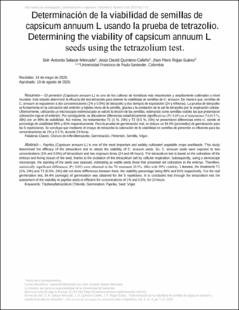Determinación de la viabilidad de semillas de capsicum annuum L usando la prueba de tetrazolio
Artículo de revista
2020-09-01
Aibi revista de investigación, administración e ingeniería
Colombia
El pimentón (Capsicum annuum L) es uno de los cultivos de hortalizas más importantes y ampliamente cultivados a nivel
mundial. Este estudio determinó la eficacia del test tetrazolio para obtener la viabilidad de semillas de C. annuum. De manera que, semillas de
C. annuum se expusieron a dos concentraciones (1% y 0.5%) de tetrazolio y dos tiempos de exposición (24 y 48horas). La prueba de tetrazolio
se fundamenta en la coloración del embrión y tejidos vivos de la semilla, gracias a la oxidación de la sal de tetrazolio por la respiración celular.
Ulteriormente, utilizando un microscopio estereoscopio se valoró la tinción de las semillas, estimando como semillas viables las que presentaron
coloración roja en el embrión. Por consiguiente, se obtuvieron diferencias estadísticamente significativas (P≤ 0,05) en el tratamiento T4 (0.5 %,
48h) con un 99% de viabilidad. Así mismo, los tratamientos T1 (1 %, 24h) y T2 (0.5 %, 24h) no presentaron diferencias entre sí, siendo el
porcentaje de viabilidad 89% y 91% respectivamente. Para la prueba de germinación real, se obtuvo un 84.4% (promedio) de germinación para
las 5 repeticiones. Se concluye que mediante el ensayo de tetrazolio la valoración de la viabilidad en semillas de pimentón es eficiente para las
concentraciones de 1% y 0.5 %, durante 24 horas — Paprika (Capsicum annuum L) is one of the most important and widely cultivated vegetable crops worldwide. This study
determined the efficacy of the tetrazolium test to obtain the viability of C. annuum seeds. So, C. annuum seeds were exposed to two
concentrations (1% and 0.5%) of tetrazolium and two exposure times (24 and 48 hours). The tetrazolium test is based on the coloration of the
embryo and living tissues of the seed, thanks to the oxidation of the tetrazolium salt by cellular respiration. Subsequently, using a stereoscope
microscope, the staining of the seeds was assessed, estimating as viable seeds those that presented red coloration in the embryo. Therefore,
statistically significant differences (P≤ 0.05) were obtained in the T4 treatment (0.5%, 48h) with 99% viability. Likewise, the treatments T1
(1%, 24h) and T2 (0.5%, 24h) did not show differences between them, the viability percentage being 89% and 91% respectively. For the real
germination test, 84.4% (average) of germination was obtained for the 5 repetitions. It is concluded that through the tetrazolium test the
assessment of the viability in paprika seeds is efficient for concentrations of 1% and 0.5%, for 24 hours.
Descripción:
Determinación de la viabilidad de semillas de capsicum annuum L usando la prueba de tetrazolio.pdf
Título: Determinación de la viabilidad de semillas de capsicum annuum L usando la prueba de tetrazolio.pdf
Tamaño: 343.2Kb
 PDF
PDF
 LEER EN FLIP
LEER EN FLIP
Título: Determinación de la viabilidad de semillas de capsicum annuum L usando la prueba de tetrazolio.pdf
Tamaño: 343.2Kb
 PDF
PDF
 LEER EN FLIP
LEER EN FLIP
















